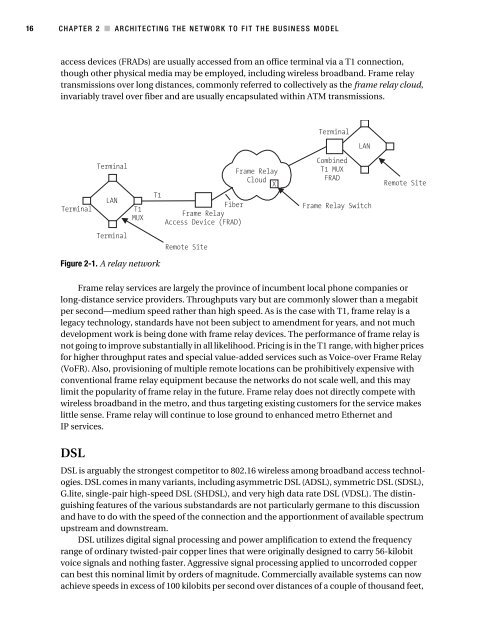WiMax Operator's Manual
WiMax Operator's Manual
WiMax Operator's Manual
Create successful ePaper yourself
Turn your PDF publications into a flip-book with our unique Google optimized e-Paper software.
16 CHAPTER 2 ■ ARCHITECTING THE NETWORK TO FIT THE BUSINESS MODEL<br />
access devices (FRADs) are usually accessed from an office terminal via a T1 connection,<br />
though other physical media may be employed, including wireless broadband. Frame relay<br />
transmissions over long distances, commonly referred to collectively as the frame relay cloud,<br />
invariably travel over fiber and are usually encapsulated within ATM transmissions.<br />
Figure 2-1. A relay network<br />
Frame relay services are largely the province of incumbent local phone companies or<br />
long-distance service providers. Throughputs vary but are commonly slower than a megabit<br />
per second—medium speed rather than high speed. As is the case with T1, frame relay is a<br />
legacy technology, standards have not been subject to amendment for years, and not much<br />
development work is being done with frame relay devices. The performance of frame relay is<br />
not going to improve substantially in all likelihood. Pricing is in the T1 range, with higher prices<br />
for higher throughput rates and special value-added services such as Voice-over Frame Relay<br />
(VoFR). Also, provisioning of multiple remote locations can be prohibitively expensive with<br />
conventional frame relay equipment because the networks do not scale well, and this may<br />
limit the popularity of frame relay in the future. Frame relay does not directly compete with<br />
wireless broadband in the metro, and thus targeting existing customers for the service makes<br />
little sense. Frame relay will continue to lose ground to enhanced metro Ethernet and<br />
IP services.<br />
DSL<br />
DSL is arguably the strongest competitor to 802.16 wireless among broadband access technologies.<br />
DSL comes in many variants, including asymmetric DSL (ADSL), symmetric DSL (SDSL),<br />
G.lite, single-pair high-speed DSL (SHDSL), and very high data rate DSL (VDSL). The distinguishing<br />
features of the various substandards are not particularly germane to this discussion<br />
and have to do with the speed of the connection and the apportionment of available spectrum<br />
upstream and downstream.<br />
DSL utilizes digital signal processing and power amplification to extend the frequency<br />
range of ordinary twisted-pair copper lines that were originally designed to carry 56-kilobit<br />
voice signals and nothing faster. Aggressive signal processing applied to uncorroded copper<br />
can best this nominal limit by orders of magnitude. Commercially available systems can now<br />
achieve speeds in excess of 100 kilobits per second over distances of a couple of thousand feet,
















